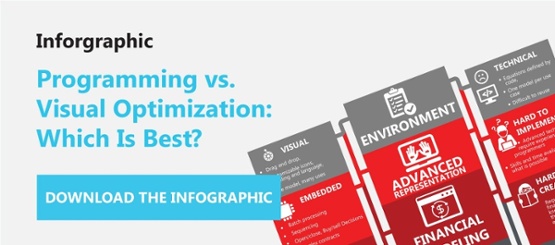Research performed by Ventana Research shows that relatively few organizations use formal supply chain software, with the majority relying extensively on spreadsheet-based supply chain planning. This may explain why more than half the companies surveyed say their supply chain plans aren't accurate or able to deliver on time. Additionally, dependence on sequential manual planning means processes take too long, hindering their ability to react optimally to changing demand. The inflexibility of manual planning systems means organizations spend enormous amounts of energy simply coping with day-to-day supply issues, leaving no time to consider supply chain optimization.
Organizations that effectively employ material requirements planning system (MRP) software don't have that problem and have time to think about other issues, such as how to optimize their supply chain. However, they too face a dilemma. Although MRP solutions excel in reliable raw material supply, most don't have optimization capabilities extending beyond the mechanics of reliable supply.
(Here's a great article on why MRP II techniques for capacity planning is no longer effective.)
The answer lies with optimization technologies that allow organizations to consider the effects of trades-off, to evaluate what-ifs, and to determine the best solution in each and every situation. This is what supply chain optimization technologies offer.
What Does Supply Chain Optimization Mean?
When considering what supply chain optimization means, it's instructive to look at what it doesn't signify. It's not about maximizing supply chain performance simply in terms of material delivery excellence to the exclusion of all else. Nor is it about exploiting the performance of a single business function in isolation without regard for its impact, positive or negative, on the organization as a whole.
Supply chain optimization means finding the solutions that lead to the most cost-effective organizational performance, taking all constraints into account. It means assessing the effect of tradeoffs, such as delivery cost against supplier costs. It includes measuring potential risks of, for example, low-cost over-the-border supply chains against more secure but higher-cost local suppliers. It evaluates scenarios such as the best plants to manufacture product lines. It even includes considerations such as how much product to sell and the most cost-effective markets in which to operate.
When considering these concepts, it's immediately apparent that true supply chain optimization extends far beyond the boundaries of conventional material sourcing and distribution. Also, that supply chain optimization enters a realm of unprecedented complexity where establishing the best solution is not straightforward or easy.
To achieve this degree of optimization, it's necessary to create business models that accurately reflect the supply chain in its entirety and use algorithms to determine the best solutions. It needs analytics such as predictive and prescriptive analytics to determine trends and the right interventions needed to optimize the supply chain. It means adopting solutions such as optimization platforms, optimization solvers and embedded optimization applications that have the ability to replicate business processes and solve complex problems.
Optimization Platforms
An optimization platform is a modeling platform used to define the characteristics of the supply chain. It uses mathematical terms and equations to reflect how a business or function operates. It accesses and stores data collected by the business. Ideally, such a model should be able to work with live data, but this is not always possible depending on the time it takes to run the model.
In order for the model to truly reflect how the business operates, it needs to take into account every significant aspect of the supply chain, including sourcing, manufacturing plants and distribution both from a capacity perspective as well as from a financial aspect.
Model preparation requires two specialist skills. Firstly, there's the need to fully understand the business and those parameters that affect the business. This entails significant input from functional managers who have in-depth knowledge of how the business and supply chain functions operate. Secondly, there's a need for analysts who have the capabilities to create models that accurately reflect the business.
There are two approaches to creating a model. The traditional approach entails coding using an optimization programming language. This is a slow, laborious process requiring the services of highly skilled OR professionals. Another approach is one that uses a drag-and-drop approach to visually create a model on the computer screen with the ability to automatically generate equations that represent inputs and outputs to each aspect of the model. In the right hands, both approaches are effective, although the drop-and-drag approach as used by River Logic's Enterprise Optimizer® is faster and more flexible than coding alternatives such as IBM's Optimization Studio.
Several vendors offer packaged optimization platforms intended to solve common problems such as for retail and distribution organizations. These packages are written for specific industries where there's a high degree of standardization across the market. They're relatively easy to install and implement but allow only a limited degree of customization. Other vendors offer more versatile solutions, but these may require a significant degree of coding and take longer to implement. While potentially more powerful, these optimization platforms require greater modeling skills.
Optimization Solvers
While an optimization platform can model how a supply chain functions, this alone is insufficient for supply chain optimization. Although models correctly predict the effects of changes, optimization platforms can't determine the best solutions. This function is performed by an optimization solver that determines the most cost-effective or profitable solution to a problem. Once a specific problem has been accurately modeled, the solver evaluates multiple alternatives to determine the optimal solution that meets certain criteria, such as which offers the lowest cost or is the most profitable.
For example, a pulp and paper company couldn't understand why increasing production didn't result in a commensurate increase in profitability until it modeled material flows through its four paper mills and used an optimization solver to understand the effects of increased production. This exercise showed that logistics constraints were affecting profitability and that by utilizing a new distribution center, distribution expenses would be lower, increasing operating income.
There are numerous solvers on the market. Some are standalone and others are part of modeling software solutions. These include mathematical and algebraic modeling, heuristics-based solvers and commercial solvers.
Embedded Applications
An embedded application is one that is closely integrated with a core business application. At the one end of the spectrum, these include analytical capabilities built into enterprise software such as the SAP analytics modules for performing predictive analytics for SAP ERP customers. Other examples are various forms of business intelligence built into ERP solutions as well as supply chain demand planning functions. At the other end of the scale are true prescriptive analytics solutions specifically developed for particular use cases. These solutions are integrated into an organization's core business applications. Embedded applications incorporate similar modeling and solver capabilities to those found in optimization platforms and solvers.
An example of an embedded application can be found at wood products manufacturer, Cox Industries. The company used River Logic's Enterprise Optimizer software to model their business and analyze profitability under different scenarios. This analysis showed that a counterintuitive change in the percentage of logs that they peeled in-house led to a 2 percent increase in revenue.
As was the case with Cox Industries, embedded applications are good for solving difficult problems in highly specialized organizations. A particular advantage of River Logic's Enterprise Optimizer is the ability to model using drag-and-drop techniques. This reduces the time needed to prepare a model and to evaluate different scenarios. A further benefit of these drag-and-drop modeling techniques is that it's easy to update models to suit organizational and structural changes in the company, something that's more difficult with solutions relying on hard coding.
Selecting the Appropriate Supply Chain Optimization Technology
Most supply chain technologies excel in the role of organizing and managing supply chains to ensure raw materials are procured as required for manufacturing. But what they don't do is evaluate whether sourcing and distribution processes are optimized. While it's true they are measurable in their effectiveness in terms of lead time, on-time delivery and efficiency, what they can't do is allow users to evaluate the effects of constraints and tradeoffs to discover the most beneficial supply chain practices in any situation.
Predictive and prescriptive analytics are tools that bridge that gap and provide line management with capabilities they need to assess tradeoffs, optimize procurement and find supply chain solutions that benefit the bottom line.
Numerous supply chain optimization technologies are available from cloud-based packages through to in-house optimization platforms and software. When choosing an optimization solution, several key aspects need to be considered.
If the solution is packaged, can it be readily adapted to the organization's needs? If a unique model is required, does the organization have access to OR professionals for coding or would a drag-and-drop solution such as offered on River Logic's Microsoft Azure platform suffice? Does the solution include out-of-the box interfaces or must they be specifically developed? Other aspects to consider include the work required to update and modify models, and whether the organization has the in-house resources to perform this work or if it should partner with a vendor.
Implementing supply chain optimization technologies requires a significant degree of effort and commitment, but the figures speak for themselves. When evaluating the benefits of supply optimization technologies against implementation costs, most organizations find the ROI exceeds expectations. In the case of Cox Industries, the ROI on their investment in prescriptive analytics was at least 300 percent, while an American Snack Food company achieved weekly savings of more than $300k through better demand planning and reduced material and transportation costs.









